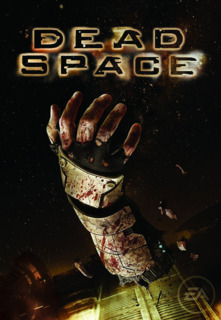Dead Space
The basis for "Dead Space's" model is obvious: "Resident Evil 4″. Whatever the view on "Resident Evil 4″, it's widely regarded as a great game [though I have some issues with it... but that's a different story], so the choice to use it as a major reference seems spot on. For all intents and purposes, "Dead Space" is "Resident Evil 4″; copied with precision and perfectionism, which is more than you can say about most plagiarists. There's the claustrophobic camera angle, the sluggish tank-like movement, the "stop, aim with laser pointer and then shoot" interaction, the overwhelming odds against hordes of living dead monsters, the silly item/weapons store in the middle of a war zone, the grueling old school inventory management, etc, etc. Its a thorough and well designed facsimile. Even the less obvious notions that made "Resident Evil 4″ a success are mimicked. For instance, level structure: like in "Resident Evil 4″, levels are built as mini-roller-coasters, each starting with a slow crescendo of enemies, properly paced with exploration sequences, but quickly ramping up to a succession of hectic encounters with several monsters. The result is a non-stop thrill ride till the end… and that's what action games should be all about.
To add some variety into the "Resident Evil" action formula, there's the occasional puzzle. The importance of puzzles in survival horror games could be easily overlooked, but for once, it was actually understood. Because puzzles force players' mind to focus on something other than shooting enemies, they establish the perfect occasion to catch him off guard and unprepared for combat, as another batch of monsters jumps out of nowhere. It's a cheap trick of course, but a very effective one at getting your adrenaline flowing - "Dead Space" uses it constantly. Moreover, the jumpy chair moments fit perfectly with the "Resident Evil 4″ survival horror vibe, thus adding more excitement into the roller-coaster ride notion. Obviously, the puzzle models had to come from somewhere else, and, once again, our student did the job. He borrowed from "Half Life 2's" gravity gun, arguably the best use of environmental puzzles in modern videogames; "Prey's" gravity twisting, which allowed players to run through walls and ceilings, a great idea left undeveloped in the original game; and the now standard time bending mechanics from… well any game with time bending - which game is complete without it?
What Bret Robins lacked in his formal exercise was something that could weave all these game design fabrics into a consistent piece - he needed a game world, a set of artistic assets that could establish a believable background for the interactions. Consistent with his approach, he turned to classic horror movies, specifically, sci-fi horror movies. He took the "Alien" saga's set up, the environment and religious undertone from "Event Horizon", spiced it up with a monster design based on "The Thing", and weaved everything together with a story. The result is a dark, moody scenario, perfect for any survival horror game. And because it's sci-fi, all those crazy game design notions could be made believable - in the future, anything is possible. The only thing left was how to translate the story. The word out on the media is that cutscenes are a thing of the past, so "Dead Space" avoids them by incorporating the narrative devices from "Bioshock" (or its predecessors, "System Shock" and its sequel), most notably, the use of disembodied objects, such as text-logs, audio-logs and video-logs, to translate story. The choice is a smart one, because, like in "Bioshock", these elements effectively allow for the absence of characters' physical presence, thus enhancing a sense of loneliness and helplessness face the environment - a crucial factor in a survival horror themed game. Once again, our student passes with flying colors.
But though the exercise was pulled off, there's something fundamentally wrong with this approach. Copying from others in such a systematic fashion may achieve good results, but can only be regarded as plagiarism, something that challenges the very notion of Art - which is based on human creativity, not xeroxing. That's one of the greatest problems in this industry, this notion that mimicking others is a good way to achieve great products - the result is out there for every one to see: endless remakes, sequels and rehashes flood the market every year. Furthermore, even if one could accept this academic process as a valid notion on how to address game design, "Dead Space" could still be criticized. Because, though its author had the knowledge and the resources to pull off the formal requirements, he lacked the ability to reinterpret his references in a meaningful, artistically profound way. His blind faith in successful design models stopped him from criticizing and deconstructing those references, in the process reconstructing what could've been a new game, that though based on a couple of references, went further with its own ideas. But there are no original ideas in "Dead Space" save a few stylized gimmicks (dismemberment shooting, in-game HUD/menu system viewed as a hologram, …). The end result is a well executed work, that while amusing in itself, never transcends the sum of its numerous parts. Adding to that, its infatuation with superficial gimmicks and technical minutiae leaves its core experience a hollow shadow of its predecessors. It ends up lacking texture and density in every one of its expressive vehicles: the story is detached and bland, its environments are too predictable and dull to become scary, and as a pure action thrill, you can't but shake the thought that it never achieves the mastery of its main reference, "Resident Evil 4″. And that's its greatest downfall. If a game doesn't add anything substantially new to its genre, and can't pair up with the game it tries so hard to imitate, then… why bother playing it? The answer is: you don't.

